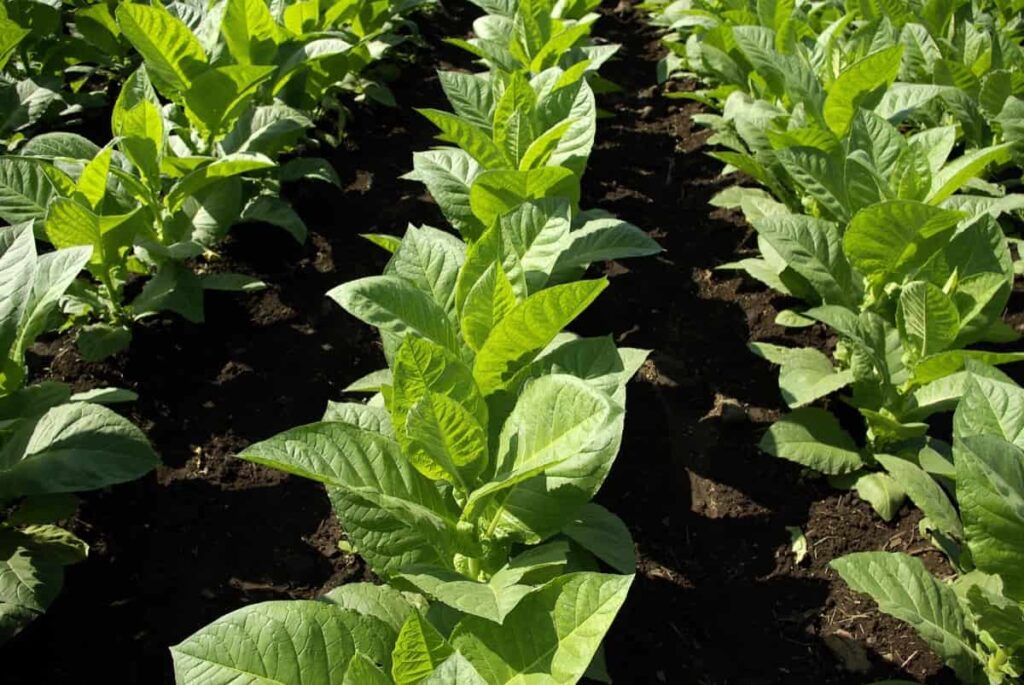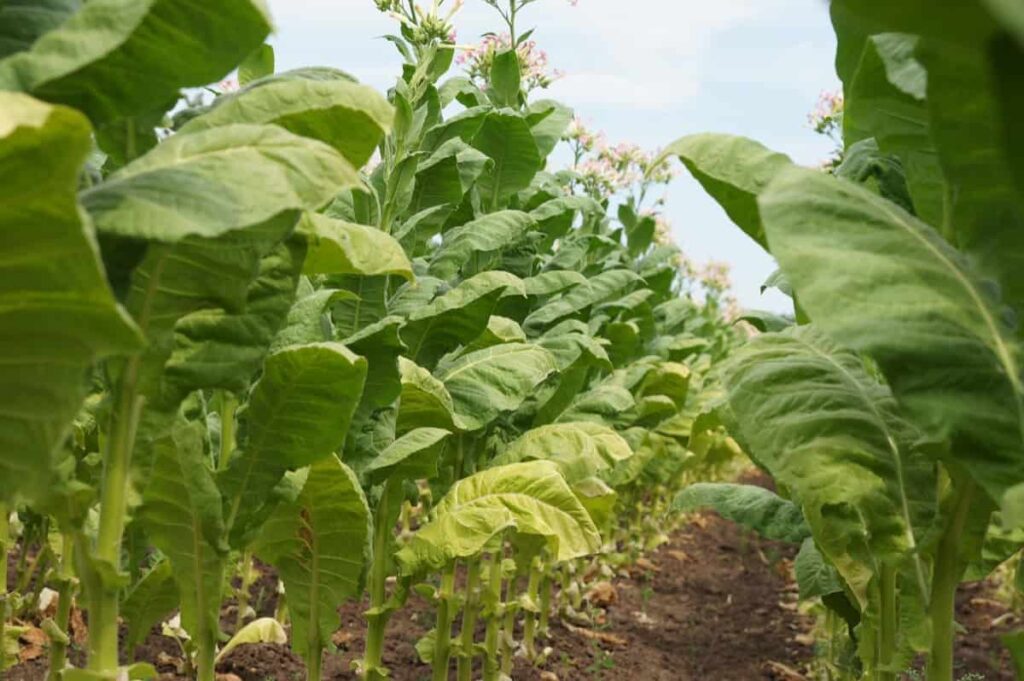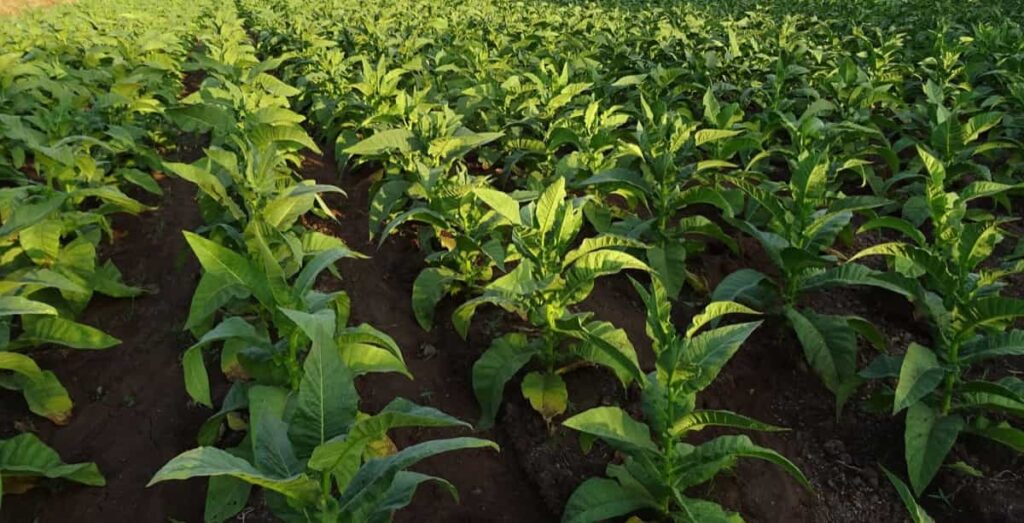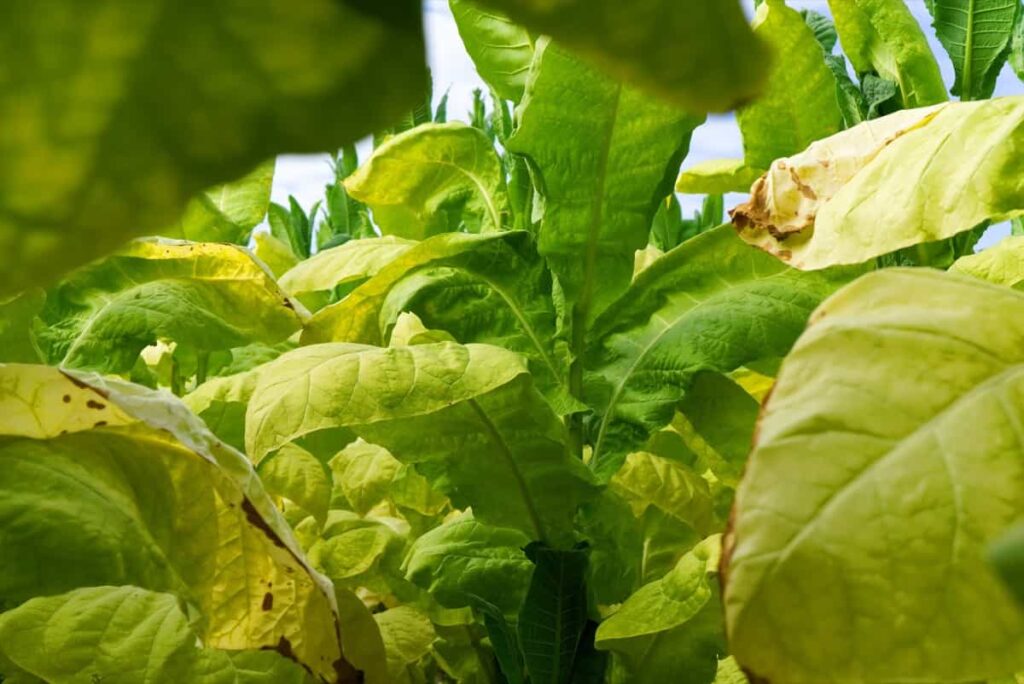In over 100 countries, Tobacco is cultivated on 4.2 million hectares, making it the world’s most important cash crop. Although Nicotiana embraces over 66 species, only two species, Nicotiana tabacum L. and Nicotiana rustica L. are grown commercially worldwide. India stands second in Tobacco cultivation, production, and exports worldwide. In India, Tobacco crop directly or indirectly supports 36 million people through production, processing, marketing, and exports.

The Tobacco plant’s stem is thick and hairy, and its leaves are oval and simple. White, cream, pink, or red flowers appear in large clusters, are tubular, and can reach 3.5-5.5 cm in length on the Tobacco plant. Tobacco may reach 4-6 feet in height and is usually grown as an annual, surviving only one growing season. While cultivating this cash crop, keep an eye on the below-discussed pests and diseases that significantly reduce crop quality and yield.
How to control pests and diseases in Tobacco crop
Diseases in Tobacco crop
Damping off
Damping off is a severe problem in Tobacco nurseries, both in heavy clay soils and light sandy soils. The disease may appear at any seedlings stage, but maximum damage is observed 5-6 weeks after sowing. It is ideal for infection and disease development when high humidity, soil moisture, cloudiness, and low temperatures below 24°C for a few days. In addition, crowded seedlings, dampness due to high rainfall, poor drainage, and excess soil solutes hamper plant growth and increase the pathogenic damping-off.
Disease symptoms
- Damping off Tobacco occurs in two stages, i.e., pre- and post-emergence phases.
- Before seedlings reach the soil surface, they are killed in the preemergence phase.
- Several young radicals and plumules have been killed, and the seedlings are completely rotten.
- Young, juvenile collar tissues become infected after emergence.
- Soft, water-soaked tissues result from infection. A seedling collapses or topples over.
Chemical control and management
- Prepare raised seed beds with adequate drainage facilities. Avoid excess watering of the seedlings.
- Burn the seed beds with paddy husk before sowing.
- Drench the seed bed with 1% Bordeaux mixture or 0.2% Copper oxychloride two days before sowing.
- Avoid overcrowding of seedlings by using recommended seed rate.
- Spray the nursery beds two weeks after sowing with 1% Bordeaux mixture or 0.2% Copper oxychloride or 0.2% Mancozeb. Repeat this at four days intervals under dry weather and at two days under wet, cloudy weather.
- Spray 0.2% Metalaxyl at ten days intervals commencing from 20 days after germination.
Frog eye leaf spot
The fungal pathogen, Cercospora nicotianae, causes frog eye leaf-spot disease on flue-cured Tobacco. This disease has historically been an issue for ripe Tobacco but has become more common over the last couple of years. The disease is commonly found on the plant’s lower, more mature leaves but can also affect green tissues. Infections are not often severe enough to impact yield but, under conducive environmental conditions, can cause severe damage to leaves.
In case you missed it: Easy Homemade Fertilizer Recipes: Natural and Organic for Houseplants, Flowers, and Garden Plants

Disease symptoms
- Both nursery and field plants are affected by the disease.
- There are several small, round brown lesions on lower and mature leaves with a diameter of 2-10 mm.
- White parchment centers are surrounded by brown or tan colored margins that resemble frog eyes on leaves.
- Under favorable conditions, several spots coalesce to form large necrotic areas, causing the leaf to dry up from the margin and wither prematurely.
Chemical control and management
- Plant nurseries should be located away from barns, and diseased debris should be disposed of as soon as possible.
- Avoiding excess nitrogen fertilization and picking over ripened leaves also helps minimize leaf spotting.
- As per the schedule suggested under damping-off, Bordeaux mixtures 0.4% (4g/lit), Zineb 0.2% (2g/lit), or 0.1% (1g/lit) Benomyl have controlled leaf spotting in seedbeds.
- After transplants have been established in the field, affected leaves are removed. Frog-eye spot can be effectively controlled with weekly applications of 0.4% (4g/lit) Bordeaux mixture, 0.1% (1g/lit) Benomyl or Thiophanate methyl, or 0.03% (0.3g/lit) 5-6 weeks after planting.
Brown spot
Fungus Alternaria longipes cause this disease. The fungus over summers in the soil as mycelium in the diseased plant debris, such as Tobacco, weeds, and other hosts. In the following season, conidia infect the lowermost leaves under favorable weather conditions. The fungus attacks the healthy tissues of all aerial parts of Tobacco of any age under high humidity as the season progresses. As a result, there is enormous spore density in the air near the end of the harvesting. The fungus persists as a mycelium in dead tissue for several months.
Disease symptoms
- Initially, it appears as small brown, concentric circular lesions on lower and older leaves that spread to upper leaves, petioles, stalks, and even capsules.
- The leaf spots enlarge, 1 to 3 cm in diameter, the centers become necroses, and they turn brown, giving the target board a distinct outline during warm weather under high humidity.
- Spots enlarge, merge, and damage large areas of the leaf, turning it dark brown in color, ragged, and unusable
Chemical control and management
- Check plants in the nursery to ensure transplants are free from the disease.
- Remove volunteer plants of Tobacco and others in the Solanum family before field planting.
- Avoid overhead irrigation, which splashes spores from soil and infected leaves, and wet leaves promoting spore germination and infection; in preference, apply water through trickle tape.
- If fungicides are required, use mancozeb, copper, or Chlorothanonil.
Tobacco mosaic disease
The Tobacco mosaic virus is most highly contagious and spreads through the sap. As a result, it is easily transmitted when a diseased plant is in contact with a healthy one. Tobacco that is air-dried is a common source of new infections. In addition, the virus may infect seedlings if workers chew or smoke natural leaf Tobacco during nursery operations. Other sources of infection and spread include old stems and leaf trash of affected plants buried in the soil. In addition, the presence of susceptible weed hosts in nurseries may cause seedlings to be affected.
In case you missed it: Agricultural Business Plan: How to Start, and Profitable Ideas

Disease symptoms
- Leaves of affected plants show mottling or mosaic patterns of light green and dark green.
- The primary symptoms are vein-clearing greenish-yellow mottling on newly formed young leaves.
- The infection results in stunted growth, malformation, distortion, and puckering of leaves in young plants.
- In addition, dark green blisters and sometimes enations (leafy growth) appear on the dorsal side of the leaf.
Chemical control and management
- There is no cure for viruses in infected plants. Remove and destroy infected plants and keep the field free of weeds that harbor the virus.
- Wash hands with soap and running water before or after handling the plants or after weeding.
- Adopt crop rotation by growing non-host plants for two seasons.
- Grow resistant varieties like TMV RR2, TMV RR 2a, and TMV RR3.
Tobacco leaf curl disease
Leaf curl is relatively widespread in all Tobacco tracts in India. Generally, the disease appears 3-5 weeks after planting and sometimes late in the nursery. An insect vector, white fly Bemisia tabaci, transmit the virus. It is also graft transmissible but not by sap or seed. There are a large number of hosts of this virus as well as of its vector.
Disease symptoms
- The infections may occur at any stage; when young plants are infected, the entire plant remains very much dwarfed.
- The curling of leaves with clearing and thickening of veins; twisting of petioles; puckering of leaves; rugose, and brittle are the important symptoms of Tobacco leaf curl disease.
- Three forms of leaf curl expression are observed. First, the leaf margins curl downward towards the dorsal side, showing the thickening of veins with enation on the lower surface.
- Second, the crinkle form shows the curling of the whole leaf edge towards the dorsal side with enation on the veins and the lamina arching towards the ventral side between the veinlets.
- Third, the transparent symptom shows leaves curling towards the ventral side, clearing the veins and absent enations.
Chemical control and management
- Remove and destroy the diseased Tobacco seedlings before and after planting whenever they are seen in the field. Fill the gaps with healthy seedlings if it is not too late.
- Alternate weed hosts for whitefly should be removed and destroyed.
- In endemic areas, Sesbania sp. may be grown as a barrier crop around Tobacco fields.
- Install 12 yellow sticky traps (castor oil coated) per hectare to monitor the whitefly population. If 100-200 whiteflies stick to the trap, the following insecticide schedule has to be adopted.
| Schedule | Chemical compound | Dosage (Per 10 lit of water) |
| 1st spray | Chlorpyrifos 20% EC. | 25 ml |
| 2nd spray | Monocrotophos 36%, W.S.C. | 15 ml |
| 3rd spray | Acephate 75% SP. | 10 grams |
| 4th spray | Demeton-s-methyl 25% EC. | 15 ml |
- Spraying has to be done preferably in the evening hours with high-volume spraying, and it should be ensured that the underside of the leaves also is covered.
In case you missed it: Cinnamon Farming Business Plan: A Profitable Production Guide for Beginners

Pests in Tobacco farming
Tobacco caterpillar
The adult is a dark-colored moth with white wavy markings on the forewings. Its hind wings are white with brown margins, and its body is about 22mm long. Its eggs are laid in clusters on foliage and are covered with brown hairs. Caterpillars are pale brown with a slight greenish-to-violet color. They have yellowish-green dorsal stripes and lateral white bands. They pupate in the soil, remaining inside silken bodies.
Symptoms
- In the early stages, the caterpillars are gregarious and scrape the leaf lamina’s chlorophyll content, giving it a papery white appearance.
- Later they become voracious feeders making irregular holes in the leaves.
- Irregular holes on leaves initially and later skeletonization leaving only veins and petioles
- Heavy defoliation.
Biological control
- Install traps with Spodolure (a pheromone) for monitoring the moths
- Collect and destroy egg masses and larvae mechanically. Regular scouting is needed to locate egg masses and leaf skeletons
- Release egg parasitoids Trichogramma chilonis in the crop fields for six weeks at 50000 eggs per ha per week soon after the appearance of moths
- Spray neem-based pesticides such as Margosom 5 ml per liter of water
- Spray aqueous extracts of neem, chinaberry, Malabar nut, or Indian privet at 200 g of leaves (soaked overnight) per liter of water
Chemical control
- Spray Tobacco decoction, i.e., 250 g Tobacco+ 30 g liquid soap+4 liter of water boiled for 30 minutes and diluted at 1:4 parts of water
- Spray spodoptera NPV (nuclear polyhedrosis virus) 250 LE per hectare + 1% jaggery along with sticker (0.5 ml Beepol/liter) in the evening hours
- Use poison baiting. Spread poison baits in furrows. Mix 10 kg rice or wheat bran + 1 kg of jaggery + 500 g Dursban [chlorpyrifos] 3% G) and repeat the baiting for 2-3 days
- If the application of chemical pesticides is required, spray a 0.05 % solution of malathion 50 EC at 7-day intervals
Whitefly
Bemisia tabaci is a Whitefly species that primarily targets Nicotine plants but can also be found on other plants in the Solanaceae family, particularly tomatoes. They’re common plant pests in agriculture and horticulture. Not only do Whiteflies impact a plant’s ability to photosynthesize, but they are also sometimes vectors of disease.
Symptoms
- These tiny white flies cause leaf curl disease in the nursery and main field. The leaves of curled plants are twisted, puckered, and thickened with abnormally prominent veins.
- Chlorotic, spotting veins and leaf yellowing, blotching, and mosaic of leaves together with leaf curling
- The plants show stunted growth, and the yields are reduced.
Biological control
- Avoid leaf curl-affected seedlings while transplanting in the field.
- Remove and destroy alternate weed hosts.
- Do not grow crops like brinjal and sunflower in the vicinity of Tobacco fields.
- If the population of leaf curl-infested plants is less than 2% within one month after planting, remove and destroy them.
- Twelve yellow stickies (castor oil coated) traps per hectare are installed to monitor the white fly population.
In case you missed it: Carrot Farming Business Plan: How to Grow from Seed to Harvest

Chemical control
- If the whitefly population is 100 per sticky trap, the following spray schedule of insecticides is given at weekly intervals commencing from 4 weeks after germination.
| Schedule | Chemical compound | Dosage/Hectare |
| 1st spray | Imidacloprid 200 SL | 125 ml in 500-800 L of water |
| 2nd spray | Chlorpyriphos 20 EC | 1.25 L in 500-800 L of water |
| 3rd spray | Thiamethoxam 25 WG | 100 g in 500-800 L of water |
| 4th spray | Acephate 75 SP | 500 g in 500-800 L of water |
Root-knot nematode
Meloidogyne nematodes cause root-knot nematodes of Tobacco. Root-knot nematodes are multi-cyclic pathogens that survive in the soil. Females produce eggs throughout the growing season. After emerging from eggs, juvenile nematodes move through water films to find a new host plant. Juveniles are attracted to root exudates produced by plants and enter through root-growing tips. While in the root tissue, the nematode changes from a worm shape to a ballon-shaped female. These females are sedentary and feed on the giant cells produced by the plant.
Symptoms
- Formation of galls on the host root system is the primary symptom
- Roots branch profusely starting from the gall tissue causing a ‘beard root’ symptom
- Infected roots become knobby and knotty
- The root system is reduced in severely infected plants, and the rootlets are almost completely absent. The roots are seriously hampered in their function of uptake and transporting water and nutrients
- During the hot part of the day, plants wilt, especially under dry conditions, and become stunted
- Nematode infection predisposes plants to be fungal and bacterial root pathogens
Biological control
- Crop rotation with graminaceous crops.
- Intercropping of marigolds reduces the nematode population.
- Seedlings should be raised in nematode-free sites or fumigated or solarized.
- Deep summer plowing at ten days intervals reduces the juvenile population.
- Infestations can be reduced by growing beneficial nematodes, bacteria, and fungi in healthy soil with plenty of organic matter. Application of decomposed poultry manure at 200 g/sq. m.
Chemical control
- broadcast Dazomet pesticide at 1.5 kg for each bed of 30 square meters. Mix the chemical with soil by cultivating the bed using a new hoe across and along the bed 14 days before sowing.
- Alternatively, you can use Metham sodium should be drenched on the seedbed at the rate of 3 liters in 30 liters of water for a bed of 30 square meters. Drench the chemical 14 days before sowing.
Gram pod borer/budworm/capsule borer
Symptoms
- During the vegetative phase, larvae feed on bud leaves and surrounding leaves. During the flowering/ capsule formation stage, larvae feed on flower buds, flowers, and capsules, and seeds are eaten severely and wholly hollowed out.
- While feeding, the caterpillar thrust its head inside, leaving the rest of the body outside.
- Bored capsules with round holes.
- Damaged bud leaves, shoots, and buds
- The activity of Helicoverpa starts on the green gram, summer vegetables, and maize and continues their generation by Oct-Nov months, synchronizing with the main crop.
Biological control
- Grow resistant cultivars like Sumatra
- Release and encourage the count of natural predators to gram pod borer like lacewing, ladybird beetle, spider, red ant, dragonfly, robber fly, and reduviid bug.
- And also, praying mantis, black drongo, common mynah, big-eyed bug earwig, ground beetle, etc., serves the same in the main field.
- Affected seedlings should be removed and destroyed.
- After completion of harvest, uproot and burn the borer-affected plants to prevent carryover of the past to the next season.
In case you missed it: Terrace Gardening ideas for Home in India: For Vegetables, Fruits, Flowers, and Herbs

Chemical control
- In Tobacco nurseries, spray chlorpyriphos 20 EC at 0.05% (20 ml in 10 L of water) at 30 and 40 days after germination. The final spray should be given before pulling out seedlings.
- In planted crops, spray cholrpyriphos 20 EC 1.0 L in 500 – 800 L of water per ha at 20 and 30 days after planting.
Conclusion
Tobacco crops can be suspected to attack by numerous insects, pathogenic fungi, bacteria, viruses, and nematodes. Its foliage and flowers make Tobacco an attractive host for many insects and the diseases they carry. Proper management and control methods discussed above can prevent these problems and reduce the effect on yields.
- Profitable Village Farming Business Ideas in 2024
- High-Yield Aquaculture: Fast-Growing Fish for Farming
- Effective Fish Pond Construction Techniques for Beginners
- Irrigation and Water Management in Pineapple Farming
- Blossom to Harvest: Mastering Flowering and Pollination in Papaya Farming
- Pig Fattening Essentials: From Selection to Sale for Beginners
- Raising Wagyu Cattle: A Complete Guide for Premium Beef Production
- Soil Types and Their Water Holding Capacity
- Optimizing Irrigation Schedules for Coconut Groves for Enhanced Yield
- Espresso Your Garden: Coffee Grounds for Healthier Acid-Loving Plants
- The Best Soil Mix for Snake Plants: How to Mix Your Own Snake Plant Soil
- Green Thumb Success: Expert Tips for Cultivating Greenhouse Beans All Year Round
- Bloom All Year Round: The Ultimate Guide to Indoor Hyacinth Care
- Eco-Friendly Gardening: How to Make Liquid Fertilizer from Kitchen Waste
- Ultimate Guide to Grow Anise in Pots: Explore Seed Propagation to Harvesting
- Guide to Raising Chester White Pigs: Discover Breed Facts to Growth Management
- Mastering the Elegance: The Ultimate Guide to Weeping Cherry Tree Care, Planting, and Maintenance
- Ultimate Guide to Planting Garlic in Grow Bags: Growing Strategies for Beginners
- How to Fix Spider Plant Leaf-Related Problems: Natural and Organic Remedies
- 10 Reasons Why Your Tulsi Plant is Shedding Leaves: Home Remedies and Solutions
- Optimizing Growth and Yield: The Advantages of Palm Bunch Ash Fertilizer
- Utilizing Neem Oil Extract as a Natural Pesticide for Hydrangea
- From Soil to Harvest: Various Ways in Which Farmers Can Use AI Tools
- Steps to Encourage and Induce Citrus Flowers: A Comprehensive Guide
- How to Fix Snake Plant Leaf-Related Issues: Natural and Organic Remedies
- Transform Your Garden into a Fragrant Oasis with Raat Ki Rani (Night Blooming Jasmine)
- Discover the Ideal Chicken Breeds for Philippine Farms
- How to Create a Poultry Egg Farm Business Plan for Profits
- Grow Lemon Cucumbers Like a Pro: Insider Techniques for Bountiful Yields
- Ultimate Guide to Caring for Your Pink Princess Philodendron: Tips for Thriving Variegation
- Areca Nut Profit Per Acre: Calculating Yield and Cost of Cultivation
- How Kaveri Chicken is Becoming a More Profitable Breed in Indian Backyards
- Transform Your Barn: 9 Steps to Convert a Horse Stall into a Chicken Coop
- Exploring Suffolk Sheep Disadvantages with Limitations and Challenges
- Guide to Solving Potted Lemon Tree Problems: How to Revive Lemon Tree in Containers
- Steps to Encourage Female Pumpkin Flowers: Best Strategies for More Flowers and High Yields
